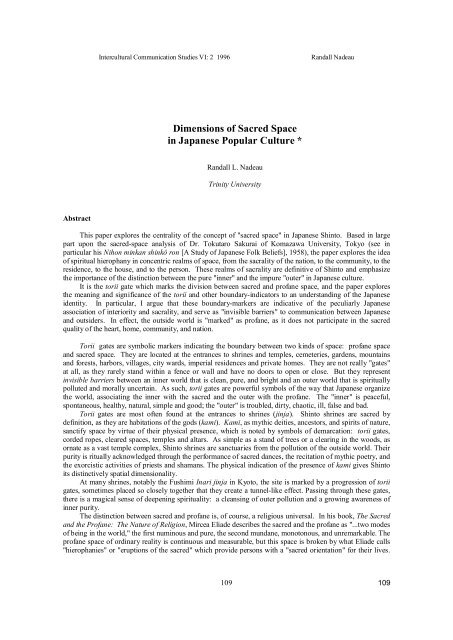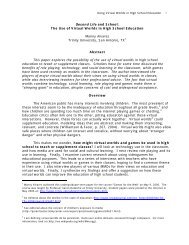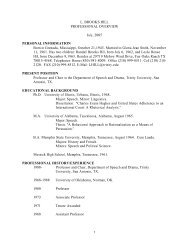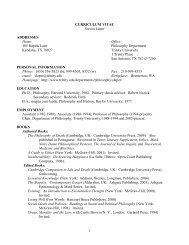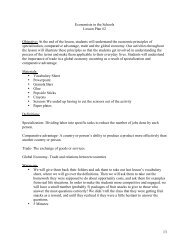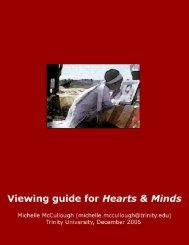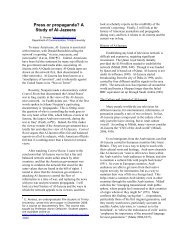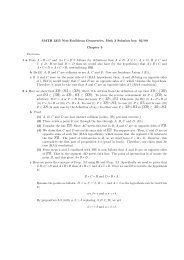Dimensions of Sacred Space in Japanese ... - Trinity University
Dimensions of Sacred Space in Japanese ... - Trinity University
Dimensions of Sacred Space in Japanese ... - Trinity University
Create successful ePaper yourself
Turn your PDF publications into a flip-book with our unique Google optimized e-Paper software.
Abstract<br />
Intercultural Communication Studies VI: 2 1996 Randall Nadeau<br />
<strong>Dimensions</strong> <strong>of</strong> <strong>Sacred</strong> <strong>Space</strong><br />
<strong>in</strong> <strong>Japanese</strong> Popular Culture *<br />
Randall L. Nadeau<br />
Tr<strong>in</strong>ity <strong>University</strong><br />
This paper explores the centrality <strong>of</strong> the concept <strong>of</strong> "sacred space" <strong>in</strong> <strong>Japanese</strong> Sh<strong>in</strong>to. Based <strong>in</strong> large<br />
part upon the sacred-space analysis <strong>of</strong> Dr. Tokutaro Sakurai <strong>of</strong> Komazawa <strong>University</strong>, Tokyo (see <strong>in</strong><br />
particular his Nihon m<strong>in</strong>kan sh<strong>in</strong>kô ron [A Study <strong>of</strong> <strong>Japanese</strong> Folk Beliefs], 1958), the paper explores the idea<br />
<strong>of</strong> spiritual hierophany <strong>in</strong> concentric realms <strong>of</strong> space, from the sacrality <strong>of</strong> the nation, to the community, to the<br />
residence, to the house, and to the person. These realms <strong>of</strong> sacrality are def<strong>in</strong>itive <strong>of</strong> Sh<strong>in</strong>to and emphasize<br />
the importance <strong>of</strong> the dist<strong>in</strong>ction between the pure "<strong>in</strong>ner" and the impure "outer" <strong>in</strong> <strong>Japanese</strong> culture.<br />
It is the torii gate which marks the division between sacred and pr<strong>of</strong>ane space, and the paper explores<br />
the mean<strong>in</strong>g and significance <strong>of</strong> the torii and other boundary-<strong>in</strong>dicators to an understand<strong>in</strong>g <strong>of</strong> the <strong>Japanese</strong><br />
identity. In particular, I argue that these boundary-markers are <strong>in</strong>dicative <strong>of</strong> the peculiarly <strong>Japanese</strong><br />
association <strong>of</strong> <strong>in</strong>teriority and sacrality, and serve as "<strong>in</strong>visible barriers" to communication between <strong>Japanese</strong><br />
and outsiders. In effect, the outside world is "marked" as pr<strong>of</strong>ane, as it does not participate <strong>in</strong> the sacred<br />
quality <strong>of</strong> the heart, home, community, and nation.<br />
Torii gates are symbolic markers <strong>in</strong>dicat<strong>in</strong>g the boundary between two k<strong>in</strong>ds <strong>of</strong> space: pr<strong>of</strong>ane space<br />
and sacred space. They are located at the entrances to shr<strong>in</strong>es and temples, cemeteries, gardens, mounta<strong>in</strong>s<br />
and forests, harbors, villages, city wards, imperial residences and private homes. They are not really "gates"<br />
at all, as they rarely stand with<strong>in</strong> a fence or wall and have no doors to open or close. But they represent<br />
<strong>in</strong>visible barriers between an <strong>in</strong>ner world that is clean, pure, and bright and an outer world that is spiritually<br />
polluted and morally uncerta<strong>in</strong>. As such, torii gates are powerful symbols <strong>of</strong> the way that <strong>Japanese</strong> organize<br />
the world, associat<strong>in</strong>g the <strong>in</strong>ner with the sacred and the outer with the pr<strong>of</strong>ane. The "<strong>in</strong>ner" is peaceful,<br />
spontaneous, healthy, natural, simple and good; the "outer" is troubled, dirty, chaotic, ill, false and bad.<br />
Torii gates are most <strong>of</strong>ten found at the entrances to shr<strong>in</strong>es (j<strong>in</strong>ja). Sh<strong>in</strong>to shr<strong>in</strong>es are sacred by<br />
def<strong>in</strong>ition, as they are habitations <strong>of</strong> the gods (kami). Kami, as mythic deities, ancestors, and spirits <strong>of</strong> nature,<br />
sanctify space by virtue <strong>of</strong> their physical presence, which is noted by symbols <strong>of</strong> demarcation: torii gates,<br />
corded ropes, cleared spaces, temples and altars. As simple as a stand <strong>of</strong> trees or a clear<strong>in</strong>g <strong>in</strong> the woods, as<br />
ornate as a vast temple complex, Sh<strong>in</strong>to shr<strong>in</strong>es are sanctuaries from the pollution <strong>of</strong> the outside world. Their<br />
purity is ritually acknowledged through the performance <strong>of</strong> sacred dances, the recitation <strong>of</strong> mythic poetry, and<br />
the exorcistic activities <strong>of</strong> priests and shamans. The physical <strong>in</strong>dication <strong>of</strong> the presence <strong>of</strong> kami gives Sh<strong>in</strong>to<br />
its dist<strong>in</strong>ctively spatial dimensionality.<br />
At many shr<strong>in</strong>es, notably the Fushimi Inari j<strong>in</strong>ja <strong>in</strong> Kyoto, the site is marked by a progression <strong>of</strong> torii<br />
gates, sometimes placed so closely together that they create a tunnel-like effect. Pass<strong>in</strong>g through these gates,<br />
there is a magical sense <strong>of</strong> deepen<strong>in</strong>g spirituality: a cleans<strong>in</strong>g <strong>of</strong> outer pollution and a grow<strong>in</strong>g awareness <strong>of</strong><br />
<strong>in</strong>ner purity.<br />
The dist<strong>in</strong>ction between sacred and pr<strong>of</strong>ane is, <strong>of</strong> course, a religious universal. In his book, The <strong>Sacred</strong><br />
and the Pr<strong>of</strong>ane: The Nature <strong>of</strong> Religion, Mircea Eliade describes the sacred and the pr<strong>of</strong>ane as "...two modes<br />
<strong>of</strong> be<strong>in</strong>g <strong>in</strong> the world," the first num<strong>in</strong>ous and pure, the second mundane, monotonous, and unremarkable. The<br />
pr<strong>of</strong>ane space <strong>of</strong> ord<strong>in</strong>ary reality is cont<strong>in</strong>uous and measurable, but this space is broken by what Eliade calls<br />
"hierophanies" or "eruptions <strong>of</strong> the sacred" which provide persons with a "sacred orientation" for their lives.<br />
109 109
Intercultural Communication Studies VI: 2 1996 Randall Nadeau<br />
Spatial hierophanies "<strong>in</strong>terrupt" space and make it non-homogeneous, and the dist<strong>in</strong>ctive realms <strong>of</strong> sacred and<br />
pr<strong>of</strong>ane space are divided by boundaries and doorways that allow one to pass from one "mode <strong>of</strong> be<strong>in</strong>g" <strong>in</strong>to<br />
the other.<br />
The threshold that separates the two spaces ... <strong>in</strong>dicates the distance between two modes <strong>of</strong> be<strong>in</strong>g,<br />
the pr<strong>of</strong>ane and the religious. The threshold is the limit, the boundary, the frontier that dist<strong>in</strong>guishes<br />
and opposes two worlds -- and at the same time the paradoxical place where those worlds<br />
communicate, where passage from the pr<strong>of</strong>ane to the sacred world becomes possible. i<br />
Sh<strong>in</strong>to, with its emphasis on defilement and purification, associates pr<strong>of</strong>ane space with pollution and<br />
evil, and sacred space with purity and brightness. ii The dichotomy between parallel clusters <strong>of</strong> concepts --<br />
<strong>in</strong>ner/sacred/pure and outer/pr<strong>of</strong>ane/polluted -- is def<strong>in</strong>itive <strong>of</strong> <strong>Japanese</strong> cosmology and the <strong>Japanese</strong> character,<br />
cutt<strong>in</strong>g across the boundaries <strong>of</strong> nature, nation, community, home, and person. For each <strong>of</strong> these concentric<br />
realms, the dist<strong>in</strong>ction between two modes <strong>of</strong> be<strong>in</strong>g is clear, marked by the torii as well as by other boundary<br />
symbols.<br />
The dist<strong>in</strong>ction between sacred space and pr<strong>of</strong>ane space, between the pure "<strong>in</strong>ner" and the impure<br />
"outer," is not limited to the boundaries <strong>of</strong> Sh<strong>in</strong>to shr<strong>in</strong>es. iii The "<strong>in</strong>ner" is the world <strong>of</strong> nature, <strong>in</strong> opposition<br />
to the cosmos and heavens. It is the nation, <strong>in</strong> opposition to what lies beyond the seas. It is the native place<br />
(rural village or city ward), <strong>in</strong> opposition to outside communities. It is the home, <strong>in</strong> opposition to the homes <strong>of</strong><br />
strangers. And it is the heart or private self, <strong>in</strong> opposition to other persons and one's own public self. All <strong>of</strong><br />
these <strong>in</strong>ner, sacred realms are marked by symbolic gates -- whether material or immaterial -- which serve to<br />
dist<strong>in</strong>guish sacred and pr<strong>of</strong>ane realities or ways <strong>of</strong> be<strong>in</strong>g.<br />
The most basic dist<strong>in</strong>ction is that between the natural world (the space <strong>of</strong> productive activity) and the<br />
cosmos or heavens, which are outside the realm <strong>of</strong> manipulation and are thereby threaten<strong>in</strong>g and<br />
unpredictable. Kami reside <strong>in</strong> both realms, but only the kami identified by symbols <strong>of</strong> sacred orientation and<br />
physical separation (shr<strong>in</strong>es, gates, etc.) are designated as part <strong>of</strong> a pure "<strong>in</strong>ner" realm. Shr<strong>in</strong>es to the kami <strong>of</strong><br />
the cosmos/heavens such as Amaterasu and Susano-o serve to "domesticate" these deities and br<strong>in</strong>g them <strong>in</strong>to<br />
the "<strong>in</strong>ner" world.<br />
The heavens represent one "outside" world. The space beyond the seas represents another. The islands<br />
<strong>of</strong> Japan are sanctified by the kami <strong>of</strong> nature and by the creator-kami <strong>of</strong> the mythic chronicles (Kojiki and<br />
Nihongi). The dramatic torii at Miyajima, as well as similar <strong>of</strong>f-shore gates symbolically surround<strong>in</strong>g the<br />
<strong>Japanese</strong> islands, show that Japan itself is "<strong>in</strong>ner" and sacred, a closed circle isolated from the threaten<strong>in</strong>g and<br />
impure space beyond the seas. At the center <strong>of</strong> the circle stands Mt. Fuji, div<strong>in</strong>e symbol and axis mundi <strong>of</strong> the<br />
sanctified world. iv And with<strong>in</strong> this world are the protective kami <strong>of</strong> natural features, <strong>in</strong>habit<strong>in</strong>g the space <strong>of</strong><br />
the productive field. The kami <strong>of</strong> the natural world are sanctify<strong>in</strong>g agents for the nation as a whole,<br />
exorcis<strong>in</strong>g evil and purify<strong>in</strong>g the land by their presence.<br />
On a microcosmic level, the dist<strong>in</strong>ction between <strong>in</strong>ner and outer applies to the <strong>in</strong>dividual community,<br />
home, and person, all demarcated by "gates" or thresholds that serve as boundaries between the sacred and the<br />
pr<strong>of</strong>ane. These may not be physical torii-style gates, but the division between <strong>in</strong>ner and outer is marked<br />
symbolically.<br />
The village or neighborhood community is bounded by small shr<strong>in</strong>es <strong>in</strong>dicat<strong>in</strong>g the protective presence<br />
<strong>of</strong> local kami, isolat<strong>in</strong>g it from the outside. These <strong>in</strong>clude the kami <strong>of</strong> fields, ponds, streams, and bridges, all<br />
marked by their shr<strong>in</strong>es (<strong>of</strong>ten simple structures only a few feet or even a few <strong>in</strong>ches <strong>in</strong> height). Most<br />
significant are the shr<strong>in</strong>es <strong>of</strong> the dôsoj<strong>in</strong>, the boundary gods protect<strong>in</strong>g travelers and oversee<strong>in</strong>g the<br />
community as a unified whole.<br />
A similar function is performed by the fence or wall surround<strong>in</strong>g the <strong>in</strong>dividual residence, which, <strong>in</strong> the<br />
rural household, is sanctified by the kami <strong>of</strong> the traditional farm build<strong>in</strong>gs: storehouse, shed, barn, and latr<strong>in</strong>e.<br />
Walls and fences are obvious boundary markers separat<strong>in</strong>g the pure <strong>in</strong>ner and impure outer, and are a<br />
common architectural feature <strong>of</strong> a variety <strong>of</strong> structures. The effect is heightened when fences are encased<br />
with<strong>in</strong> fences, <strong>in</strong> concentric patterns <strong>of</strong> enclosure, as at the Grand Shr<strong>in</strong>e at Ise, its space so sacred that access<br />
is forbidden to ord<strong>in</strong>ary persons.<br />
The <strong>in</strong>ner purity <strong>of</strong> the household itself is protected by the vestibule or entranceway (genkan) where<br />
shoes are removed, guests are greeted, and rites <strong>of</strong> purification are performed when the house is consecrated<br />
110 110
Intercultural Communication Studies VI: 2 1996 Randall Nadeau<br />
by the Sh<strong>in</strong>to priest. Each room <strong>of</strong> the house has its protective kami, with altars to ancestors and, <strong>in</strong><br />
traditional homes, to gods <strong>of</strong> the fireplace, kitchen, and alcove.<br />
Perimeter shr<strong>in</strong>es, fences, and entryways all serve as protective barriers between pr<strong>of</strong>ane and sacred<br />
space.<br />
In terms <strong>of</strong> personal psychology and social relations, there are also symbolic barriers between <strong>in</strong>ner and<br />
outer. Among East Asian cultures, Japan is unique <strong>in</strong> preserv<strong>in</strong>g a strong sense <strong>of</strong> the private self <strong>in</strong><br />
opposition to the public self and the social roles required by duty and position. The self (jibun) is <strong>in</strong>ner and<br />
private, and is represented by the heart (kokoro) and belly (hara), the seat <strong>of</strong> personal purity and genu<strong>in</strong>eness.<br />
The kokoro is driven by its own impulses, the "spontaneity" and "emotion" (n<strong>in</strong>jô) <strong>of</strong> the private self. And no<br />
matter what the requirements <strong>of</strong> one's social position and obligations (giri), this private heart is perfect and<br />
pure. The private, <strong>in</strong>ner self is almost never expressed, except <strong>in</strong> the <strong>in</strong>dulgences <strong>of</strong> literature and film and<br />
the odd culture heroes <strong>of</strong> the popular imag<strong>in</strong>ation: the rôn<strong>in</strong>, the yakuza, the nihirisuto. v For most, the<br />
yearn<strong>in</strong>gs <strong>of</strong> the heart cannot be gratified, and public duty cannot be compromised. In fact, display<strong>in</strong>g the<br />
heart would threaten its purity, and it is precisely the facade <strong>of</strong> outward pr<strong>in</strong>ciple and pretense (tatemae) that<br />
preserves the sanctity <strong>of</strong> one's true feel<strong>in</strong>gs (honne) and keeps the kokoro free <strong>of</strong> outer pollution. vi The "gate"<br />
between <strong>in</strong>ner and outer is the face and mouth, or facial and verbal expression. Their conformity to social<br />
expectation masks and thereby <strong>in</strong>sulates the pure and sacred heart with<strong>in</strong>. vii<br />
A visit to a Sh<strong>in</strong>to shr<strong>in</strong>e affirms a resonance between the purity <strong>of</strong> the natural sett<strong>in</strong>g and the purity <strong>of</strong><br />
the private self. To pass through a torii gate is to enter a sacred realm. And so one dips a ladle <strong>in</strong>to the<br />
kuchisusu-mizu beside the gate, <strong>in</strong> order to cleanse the hands, face, and mouth. This act <strong>of</strong> purification affirms<br />
the division between <strong>in</strong>ner and outer, both <strong>in</strong> physical space and <strong>in</strong> the human body. For the <strong>in</strong>ner to rema<strong>in</strong><br />
pure, the barrier between private space and public space must be as clear as the barrier between sacred space<br />
and pr<strong>of</strong>ane space. The outer, represented primarily by the mouth (kuchisusu means "mouth-cleans<strong>in</strong>g"), is<br />
subject to pollution, as it is the medium <strong>of</strong> social conformity and pretense, which obscures the <strong>in</strong>ner purity <strong>of</strong><br />
the hara and kokoro, belly and heart.<br />
The prayers and rites performed at the shr<strong>in</strong>e do not cleanse the self, which is <strong>in</strong>herently pure, but they<br />
are exorcistic, <strong>in</strong> that they eradicate the outer pollutions that cloud one's <strong>in</strong>ner virtue and light. People visit<br />
shr<strong>in</strong>es alone, or with their families (picnics, wedd<strong>in</strong>gs), or with their def<strong>in</strong><strong>in</strong>g groups, or with their<br />
communities (matsuri festivals) to affirm the sanctity <strong>of</strong> what is <strong>in</strong>ner as opposed to what is outer. Ultimately,<br />
what is "pure and bright" belongs to the nation, community, family and self. And this <strong>in</strong>ner dimension <strong>of</strong><br />
sacred space is demarcated and protected by the <strong>in</strong>visible barriers <strong>of</strong> torii, genkan, and tatemae: gate,<br />
vestibule, public facade.<br />
* An earlier version <strong>of</strong> this paper was presented at the 4th International Conference on Cross-Cultural<br />
Communication: East and West <strong>in</strong> San Antonio, Texas, <strong>in</strong> 1993.<br />
Notes<br />
1. Mircea Eliade, The <strong>Sacred</strong> and the Pr<strong>of</strong>ane: The Nature <strong>of</strong> Religion (New York: 1959), 25. Eliade<br />
applies his analysis to the temporal dimension as well: sacred time is primordial, re-creative, and<br />
renew<strong>in</strong>g, "erupt<strong>in</strong>g" <strong>in</strong>to the pr<strong>of</strong>ane time cont<strong>in</strong>uum through worship and calendrical rites (ibid., 68-<br />
113). In Sh<strong>in</strong>to, the suspension <strong>of</strong> pr<strong>of</strong>ane time can be experienced <strong>in</strong> such occasions as the village<br />
matsuri, the recitation <strong>of</strong> found<strong>in</strong>g myths <strong>in</strong> the Kojiki and Nihonji, pilgrimages to Mt. Fuji and other<br />
sacred sites, family out<strong>in</strong>gs to village shr<strong>in</strong>es, and so on.<br />
2. On the association <strong>of</strong> the sacred with "purity" and the pr<strong>of</strong>ane with "pollution" <strong>in</strong> the comparative<br />
study <strong>of</strong> religion, see Mary Douglas' work, especially Purity and Danger: An Analysis <strong>of</strong> Concepts <strong>of</strong><br />
Pollution and Taboo (New York: 1966).<br />
3. The analysis <strong>of</strong> the spatial dimensions <strong>of</strong> Sh<strong>in</strong>to can be found <strong>in</strong> Tokutaro Sakurai, Nihon m<strong>in</strong>kan<br />
sh<strong>in</strong>kô ron (Tokyo: 1958), Shukyô to m<strong>in</strong>zoku gaku (Tokyo: 1969), and Nihon m<strong>in</strong>zoku shûkyô ron<br />
(Tokyo: 1982).<br />
4. Most religious traditions describe a sacred mounta<strong>in</strong>, where the gods reveal sacred reality to<br />
humanity. S<strong>in</strong>ce the mounta<strong>in</strong> is with<strong>in</strong> or contiguous with the social boundaries <strong>of</strong> the community,<br />
the whole nation is holy ground, as the "place nearest to heaven." Eliade, <strong>Sacred</strong> and Pr<strong>of</strong>ane, 37-41;<br />
111 111
Intercultural Communication Studies VI: 2 1996 Randall Nadeau<br />
Cosmos and History: The Myth <strong>of</strong> Eternal Return (New York: 1959), 6-21. Mt. Fuji is not only the<br />
pr<strong>in</strong>ciple symbol <strong>of</strong> the nation, but also the most sacred, and the basis <strong>of</strong> the most popular <strong>of</strong> the<br />
mounta<strong>in</strong> cults. But Fuji is not unique as a holy mounta<strong>in</strong> provid<strong>in</strong>g a "sacred orientation" for the<br />
nation. On the significance <strong>of</strong> sangaku sh<strong>in</strong>kô (mounta<strong>in</strong> beliefs) <strong>in</strong> Sh<strong>in</strong>to, see H. Byron Earhart, A<br />
Religious Study <strong>of</strong> the Mount Haguro Sect <strong>of</strong> Shugendô: An Example <strong>of</strong> <strong>Japanese</strong> Mounta<strong>in</strong> Religion<br />
(Tokyo: 1970), esp. 7-16.<br />
5. For an <strong>in</strong>sightful look at the conflict between public exterior and private self <strong>in</strong> <strong>Japanese</strong> popular<br />
culture, see Ian Buruma, Beh<strong>in</strong>d the Mask: On Sexual Demons, <strong>Sacred</strong> Mothers, Transvestites,<br />
Gangsters, Drifters and Other <strong>Japanese</strong> Cultural Heroes (New York: 1984).<br />
6. An excellent anthropological study <strong>of</strong> the dist<strong>in</strong>ction between 'pr<strong>in</strong>ciple' (tatemae) and '<strong>in</strong>tention'<br />
(honne) can be found <strong>in</strong> Brian Moeran, Language and Popular Culture <strong>in</strong> Japan (Manchester: 1989).<br />
For a suggestive study on the dist<strong>in</strong>ction between "<strong>in</strong>ner" and "outer" <strong>in</strong> <strong>Japanese</strong> culture and<br />
personality, see Kurt S<strong>in</strong>ger, Mirror, Sword and Jewel: A Study <strong>of</strong> <strong>Japanese</strong> Characteristics (New<br />
York: 1973).<br />
7. For a discussion <strong>of</strong> the symbolism <strong>of</strong> heart/belly <strong>in</strong> opposition to face/mouth, see Takie Sugiyama<br />
Lebra, <strong>Japanese</strong> Patterns <strong>of</strong> Behavior (Honolulu: 1976).<br />
112 112
Intercultural Communication Studies VI: 2 1996 Randall Nadeau<br />
i Mircea Eliade, The <strong>Sacred</strong> and the Pr<strong>of</strong>ane: The Nature <strong>of</strong><br />
Religion (New York: 1959), 25. Eliade applies his analysis<br />
to the temporal dimension as well: sacred time is primordial,<br />
re-creative, and renew<strong>in</strong>g, "erupt<strong>in</strong>g" <strong>in</strong>to the pr<strong>of</strong>ane time<br />
cont<strong>in</strong>uum through worship and calendrical rites (ibid., 68-<br />
113). In Sh<strong>in</strong>to, the suspension <strong>of</strong> pr<strong>of</strong>ane time can be<br />
experienced <strong>in</strong> such occasions as the village matsuri, the<br />
recitation <strong>of</strong> found<strong>in</strong>g myths <strong>in</strong> the Kojiki and Nihonji,<br />
pilgrimages to Mt. Fuji and other sacred sites, family<br />
out<strong>in</strong>gs to village shr<strong>in</strong>es, and so on.<br />
ii On the association <strong>of</strong> the sacred with "purity" and the<br />
pr<strong>of</strong>ane with "pollution" <strong>in</strong> the comparative study <strong>of</strong> religion,<br />
see Mary Douglas' work, especially Purity and Danger: An<br />
Analysis <strong>of</strong> Concepts <strong>of</strong> Pollution and Taboo (New York: 1966).<br />
iii The analysis <strong>of</strong> the spatial dimensions <strong>of</strong> Sh<strong>in</strong>to<br />
accompany<strong>in</strong>g Figures sub-1 to 4 is derived from Tokutaro<br />
Sakurai, Nihon m<strong>in</strong>kan sh<strong>in</strong>kô ron (Tokyo: 1958), Shukyô to<br />
m<strong>in</strong>zoku gaku (Tokyo: 1969), and Nihon m<strong>in</strong>zoku shûkyô ron<br />
(Tokyo: 1982).<br />
iv Most religious traditions describe a sacred mounta<strong>in</strong>,<br />
where the gods reveal sacred reality to humanity. S<strong>in</strong>ce the<br />
mounta<strong>in</strong> is with<strong>in</strong> or contiguous with the social boundaries<br />
<strong>of</strong> the community, the whole nation is holy ground, as the<br />
"place nearest to heaven." Eliade, <strong>Sacred</strong> and Pr<strong>of</strong>ane, 37-41;<br />
Cosmos and History: The Myth <strong>of</strong> Eternal Return (New York:<br />
113 113
Intercultural Communication Studies VI: 2 1996 Randall Nadeau<br />
1959), 6-21. Mt. Fuji is not only the pr<strong>in</strong>ciple symbol <strong>of</strong><br />
the nation, but also the most sacred, and the basis <strong>of</strong> the<br />
most popular <strong>of</strong> the mounta<strong>in</strong> cults. But Fuji is not unique<br />
as a holy mounta<strong>in</strong> provid<strong>in</strong>g a "sacred orientation" for the<br />
nation. On the significance <strong>of</strong> sangaku sh<strong>in</strong>kô (mounta<strong>in</strong><br />
beliefs) <strong>in</strong> Sh<strong>in</strong>to, see H. Byron Earhart, A Religious Study<br />
<strong>of</strong> the Mount Haguro Sect <strong>of</strong> Shugendô: An Example <strong>of</strong> <strong>Japanese</strong><br />
Mounta<strong>in</strong> Religion (Tokyo: 1970), esp. 7-16.<br />
v For an <strong>in</strong>sightful look at the conflict between public<br />
exterior and private self <strong>in</strong> <strong>Japanese</strong> popular culture, see<br />
Ian Buruma, Beh<strong>in</strong>d the Mask: On Sexual Demons, <strong>Sacred</strong><br />
Mothers, Transvestites, Gangsters, Drifters and Other<br />
<strong>Japanese</strong> Cultural Heroes (New York: 1984).<br />
vi An excellent anthropological study <strong>of</strong> the dist<strong>in</strong>ction<br />
between 'pr<strong>in</strong>ciple' (tatemae) and '<strong>in</strong>tention' (honne) can be<br />
found <strong>in</strong> Brian Moeran, Language and Popular Culture <strong>in</strong> Japan<br />
(Manchester: 1989). For a suggestive study on the<br />
dist<strong>in</strong>ction between "<strong>in</strong>ner" and "outer" <strong>in</strong> <strong>Japanese</strong> culture<br />
and personality, see Kurt S<strong>in</strong>ger, Mirror, Sword and Jewel: A<br />
Study <strong>of</strong> <strong>Japanese</strong> Characteristics (New York: 1973).<br />
vii For a discussion <strong>of</strong> the symbolism <strong>of</strong> heart/belly <strong>in</strong><br />
opposition to face/mouth, see Takie Sugiyama Lebra, <strong>Japanese</strong><br />
Patterns <strong>of</strong> Behavior (Honolulu: 1976).<br />
114 114


